As most of you know, finding a nice colored vintage Weber grill isn’t an easy thing, especially now that Weber Kettle Collecting has grown into a world-wide hobby. Now imagine this: It’s 4:30 am. In the darkness of predawn, you are taking your daily walk. You take your typical route and you stumble across an odd looking charcoal grill laying on the curbside. You’ve never seen anything like it. You take your cell phone out of your pocket and turn the flashlight on. You see what looks like a faded yellow lid, two U-shaped legs attached to the bowl, and a wheelbarrow type leg laying next to the bowl on the ground. It’s obviously a charcoal grill, it’s old, but the rest of the parts don’t make sense. You pick up all the parts, heavy and awkward as they are…and carry all of it home which happens to be 2 blocks away. This is what our new member Bill came across one dark, early morning on his daily walk…left for dead.
Later that morning, after the sun came up, Bill finally got to look at what he had. He knew it was an old Weber grill based on the what he read on the top vent. After researching his find and discovering our site, he sent an email to the WKC. Troy got the email and knew exactly what Bill had found and explained how rare this bird was. This was the elusive yellow Weber Ranger which dates back to 1965. Troy contacted Jeff since he owns two Weber Rangers himself, in hopes of helping with questions regarding parts, restoration, and repairs.
Below are some photos showing the initial condition that Bill found his Ranger in. Some of the worst damage were to the rear legs that were victim to rust and metal rot. When wheeling around these Rangers, you often see the rear legs taking the majority of the abuse at the bottom loop where they rest (and are dragged) on hard concrete and asphalt surfaces. Bill also found metal expansion in the legs which most likely was from the inability of moisture and condensation to drain out which resulted in ice (expansion) damage during outdoor storage in the winter months. Lastly, you also see that the front leg was rusted out through its original welds. The bowl needed extensive repairs.
Pre Restoration: Yellow Weber Ranger Gallery
- Weber Ranger top vent
- Original top handle of Weber Ranger
- Initial condition of Ranger bowl
- Parts found for Weber Ranger
- Ranger front leg rusted off of bowl
- Initial condition of Ranger bowl
- Photo of Weber Ranger rusted right rear leg
- Photo of left rear leg rusted out
As Bill learned more about the grill…he immediately knew how special it was. His plan wasn’t to sell it, but to restore it as close as possible to its former glory and cook on it. This grill needed extensive repairs to certain parts, was completely disassembled, and restored back to almost new condition. What Bill has now is an instant memory maker. The road to get to the finished product was going to be long and tedious. Bill realized this. Here he is after giving it a quick wipe down…hope that beer tastes good Bill! You’ve got your work cut out for you!
Beginning to Clean, Disassemble, and Repair
Some of the highlights included in the following pictures include:
- cutting out bad metal where the front leg rusted out and welding in new metal
- re-attaching the front leg socket to the new metal
- welding and building up the rotted leg sections with numerous reinforced metal strips
- add a weep hole to the bottom of the legs to drain any condensation and avoid future freeze/thaw cycles
- construct a reinforcement triangle around the legs to add support during transport (to the block parties!)
- make a new wood handle for the grill lid
- restore original plastic wheels, add white walls, repaint the center wheel design
- repaint all repaired bare metal spots on the bowl with high temperature black BBQ paint
- add new handle grips to the handle bars
- add new hardware (thumbscrews, nuts and bolts for rear leg bowl brackets).
Disassembled & Restoration Gallery
- Repaired and repainted legs
- Front Ranger wheel before rehab
- Front Ranger wheel after rehab
- Years of rust, freeze/thaw damage, along with use and abuse. Reinforced metal strip welded in.
- Weathered original handles next to newly cut handles by Bill.
- Ranger ash pan beginning the cleaning process
- Marking out the damaged areas to be removed from the Ranger leg mount area
- Damaged areas cut out with washers in place prior to welding in new metal
- Front leg socket with new metal in place
- Damaged front leg socket mounting area.
- Front leg socket back in place ready to be welded down
- Ranger ash pan and bottom vents before cleanup
- Ranger ash pan and bottom vents after clean-up
The Finished Product: Fully Restored Yellow Weber Ranger
Finally we can see all the time and hard work that Bill put into this Ranger. It’s pretty obvious that all his efforts have paid off as the results speak for themselves. It looks like a completely different grill from what he found on that one morning walk he won’t ever forget.
- Newly made homemade handle
- Cleaned Ranger bowl
- Finished Ranger left side profile
- Finished Ranger front profile
- Finished Ranger right side profile
- Finished Ranger lower half
- Ranger lid cleaned inside
- Restored Ranger rear legs with weep hole to drain condensation
- Fresh Ranger lid with new wood handle
- Ranger underside with custom triangle for leg support
First Fire and Cook
Once Bill realized the significance of this Ranger, he said from the beginning that his intentions were to restore it and cook on it. Both those boxes have now been checked. The first real cook on this Ranger was chicken. Prior to this, I asked him if he knew what was the coolest thing about owning a yellow Weber grill was. Based on the confused response I got, I knew he was in for a surprise. I told him, “go get that grill nice and hot and watch what happens”. If he didn’t know then, he sure does now. Look at the pictures below and how orange his grill turned after he removed the plated chicken.
- First fire for the newly restored Ranger
- Ranger finally back to work
- Chicken on the Ranger
- Bill didn’t know about the changing color…he does now!
To top the grill off, Bill’s wife made a custom cover that fits the Ranger like a glove. It’s in a Weber-like retro floral pattern that we saw in the 70’s and into the early 80’s. This is certainly one of the ultimate Grail “cookers” any of us have seen. Congrats Bill on a great Rescue, Restore and Respect of a vintage Weber kettle. That’s what this site is all about.

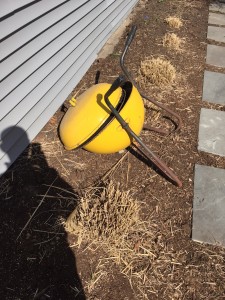
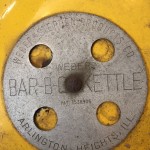
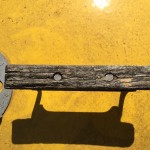
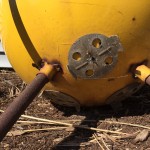
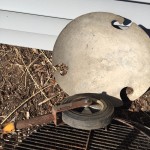
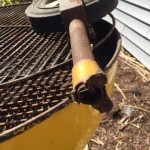
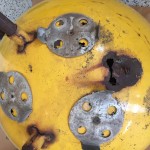
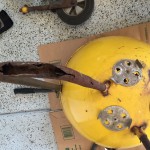
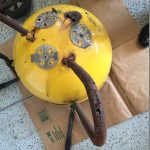
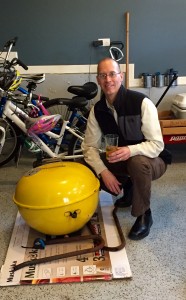
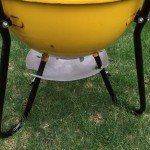
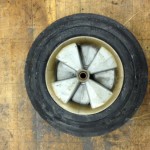
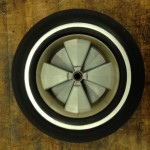
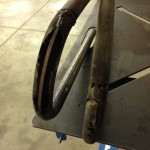
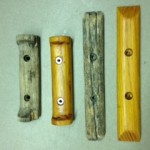
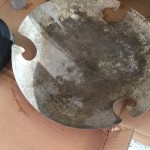
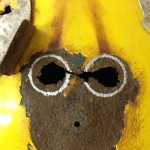
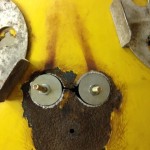
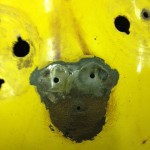
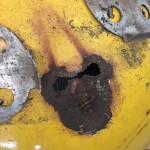
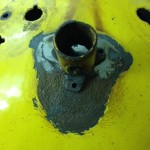
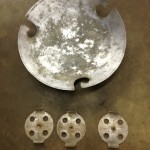
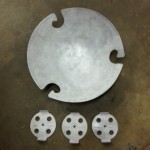
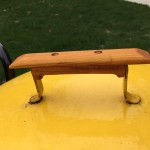
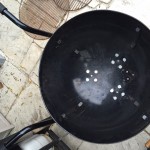
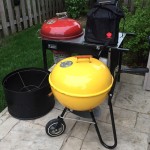
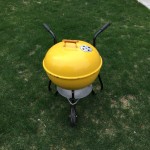
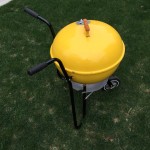
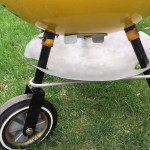
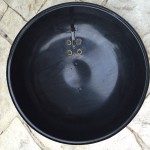
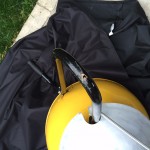
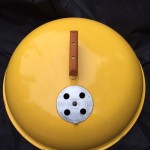
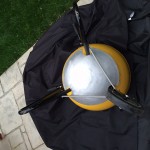
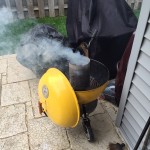
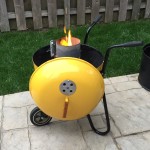
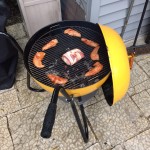
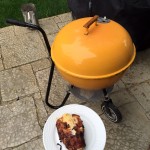
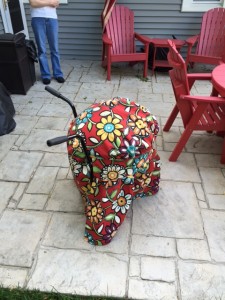
Great write-up Jeff, you captured it all really well! My only clarification is that my friend and co-worker Ron did the bulk of the work down in his shop. There is no way this grill would be in such great shape without his skills and attention to detail. THANKS RON, this grill has a family for another 50 years.
I just found my first Weber kettle from 1976 yellow 22.5 gourmet. My question is about the porcelain and fixing all the chips and cracks. Where do I find the yellow porcelain paint so I can restore this awesome little grill
Hi Erik! Congrats on finding a yellow, they’re very rare and highly sought after! Unfortunately there’s really no way to fix the porcelain enamel. It’s baked on at the factory.
Some people have attempted using high temp paint, but it NEVER holds its color and often ends up looking worse than the original damage.
Great story and write up. This to me is the perfect example of “Rescue, Restore, Respect” Congratulations Bill!
Winz
Sweet, sweet kettle! Never knew about the color change either. How cool is that! Welcome aboard Bill, that’s one heck of an introduction. Great job!
Just a stunning Recovery and Rescue on this!
That Ranger cleaned up nicely! Looks brand new!
RRR! 🙂
Well done. Rangers are soooo cool. Thanks for preserving Weber history.
WOW! What a find and such a beautiful transformation back to glory.
One question!
Where do i find a high temperature resistant original paint? I found a chocolate in about same condition. Welding is no problem, and coating inside black, but outside because its emaille?? Sorry for my english!
THX Bertl